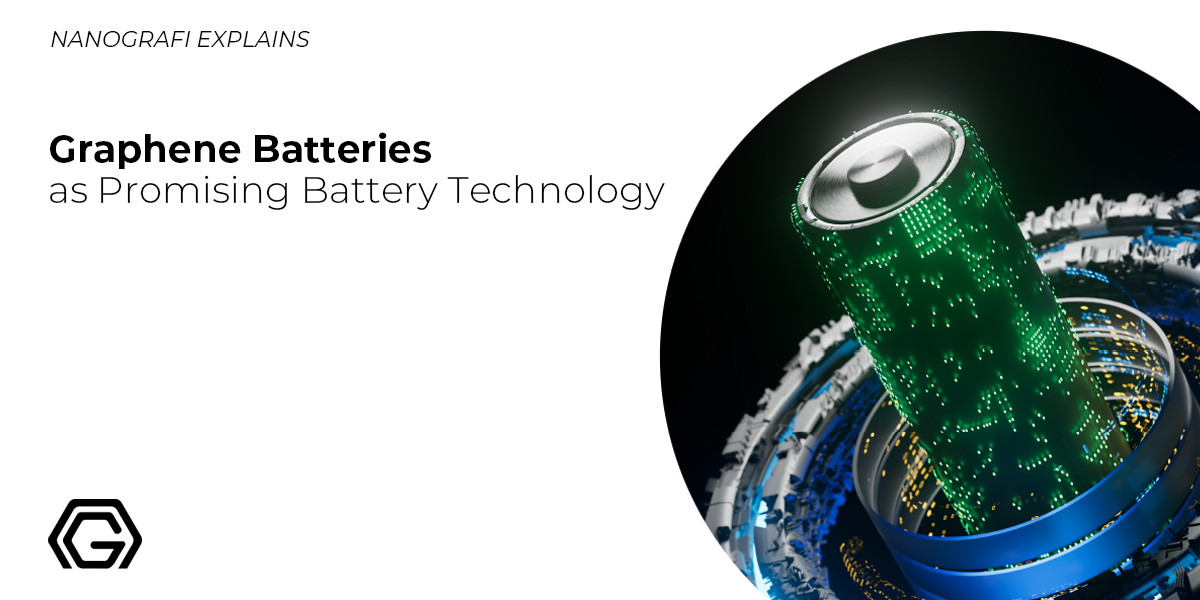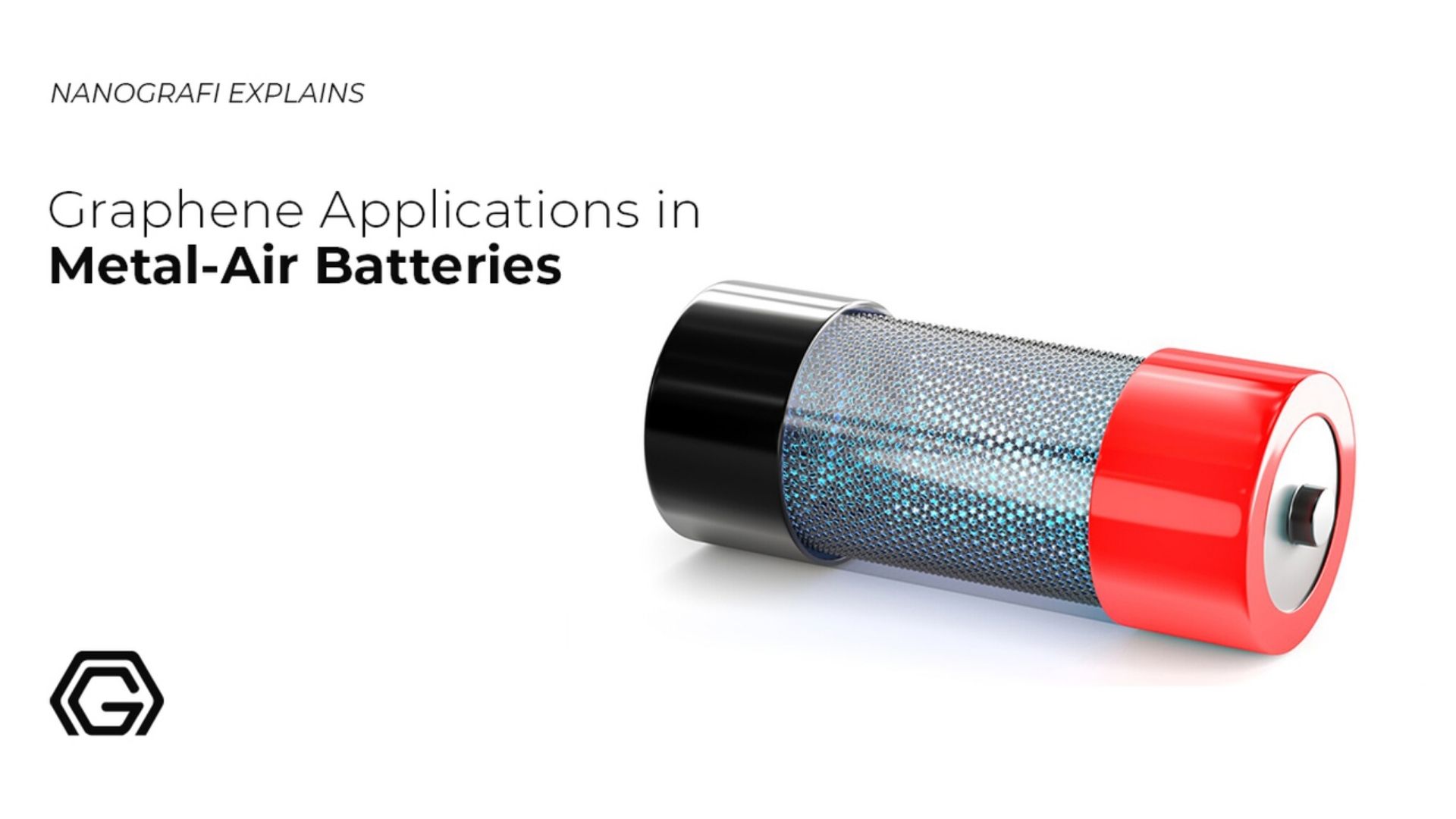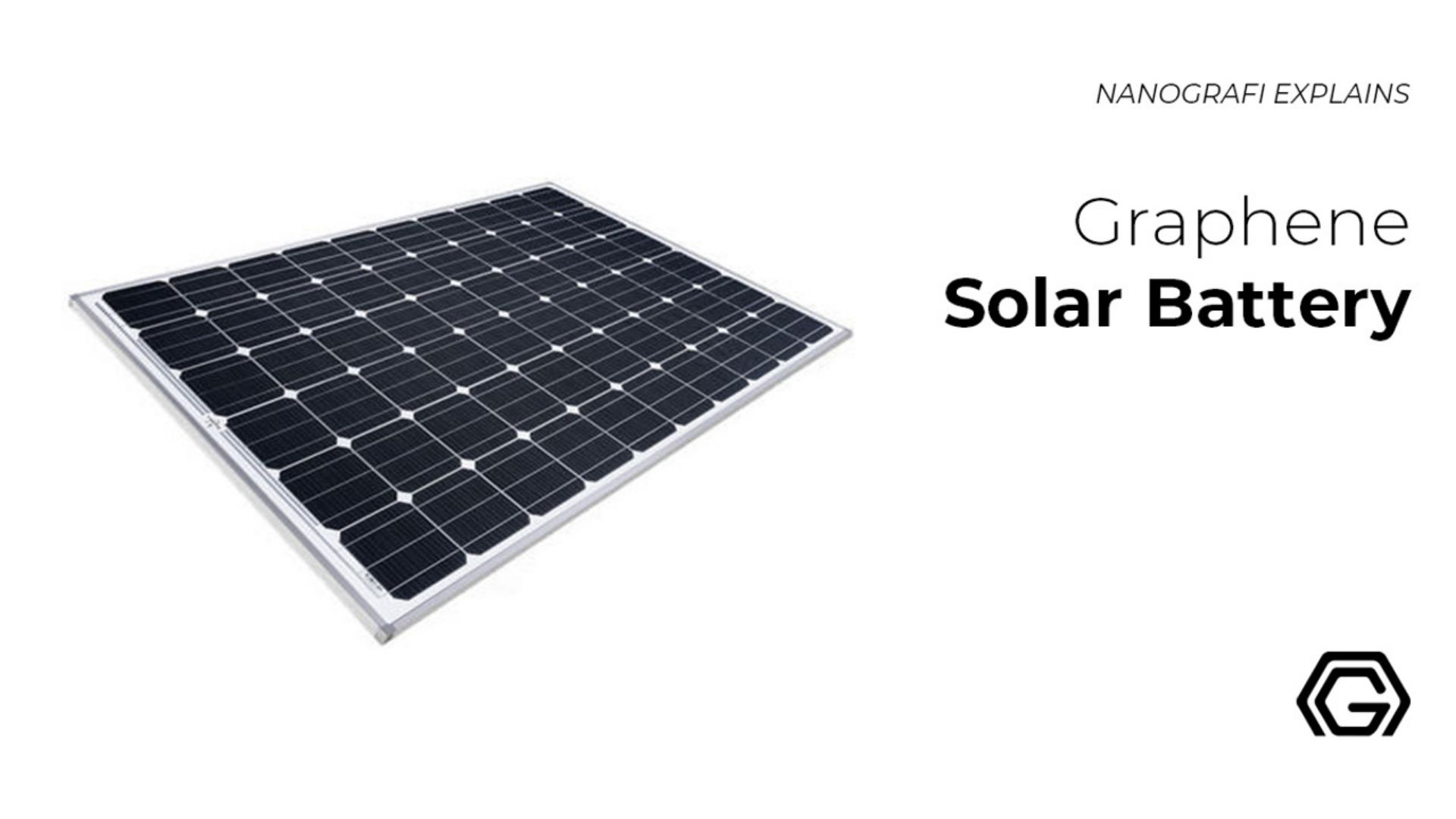Graphene Batteries as Promising Battery Technology - Nanografi
Graphene is a two-dimensional graphite structure as it is the thinnest form of graphite and is capable of doing wonders in various industries in various fields.
Graphene has a lot of benefits owing to the excellent properties and characteristics that it is capable of exhibiting and that is why graphene has a wide range of applications which is only increasing day by day. According to recent developments, graphene batteries are being introduced in the market and are proving to be a huge success as they are exhibiting some remarkable features which are highly benefiting the market and industries.
Introduction
Graphene is known as a graphite's 2-dimensional structure, where one flat carbon atom layer is arranged in a supportive honeycomb lattice. One can make graphene in various ways, including PE-CVD (plasma-enhanced chemical vapor deposition), which is the best way for the production of graphene.
Significant Advantages of PE-CVD
PE-CVD techniques' major advantages include transfer-free and catalyst-free growth and lower operating substrate temperatures. In the plasma-enhanced chemical vapor deposition method, a special mixture of the gases, including carbon, is heated into a plasma, creating a graphene layer on a nickel or copper plate. Graphene is subsequently extracted from the plate.
Graphene’s Characteristics
Graphene is simply graphite’s thinnest possible form. Graphene has a thickness of a single atomic layer, displaying a hexagonal structure that is very condensed. Once we break graphene into a single atomic layer, it possesses various remarkable characteristics and features that are different from the characteristics and features of graphite. Graphene is a very efficient electricity conductor. Graphene is both a lightweight and flexible material along with being a very strong material. 200 times more of the steel’s strength is offered by the graphene whereas its weight is only a fraction of the steel’s weight.
Similar to commercial Li-ion batteries, energy is transferred by the porous and highly conductive graphene plates for either charging or discharging the battery at a high rate. Similarities in design are shared by both the graphene and lithium-ion batteries but they have a broad range of differences.
Discovery and Synthesis of Graphene
Although graphene was supposed to exist in the early 1940s, Konstantin Novoselov and Andre Geim synthesized the monolayer graphene sheets in 2004 and it was for this achievement that they received the Nobel Prize in Physics. Scotch Tape Method is a remarkably simple synthesis method. Graphite's mechanical exfoliation can merely isolate the graphene monolayers, and adhesive tape is used to pull one layer away from the bulk.
Other Methods to Produce Graphene
There has been the development of other methods to produce graphene. Graphite's centrifugation and sonication in a liquid are included in these for creating a graphene dispersion, synthesis from sugar, known as the 'Tang-Lau method,' silicon carbide’s reduction, and the epitaxial growth by the CVD (chemical vapor deposition). It is because of the excellent characteristics and the discovery of the synthesis method that graphene is a highly researched material. There has been significant growth in the material’s scientific interest since its discovery.
Different Forms of Graphene
Usually, graphene is either handled on a substrate, in a dispersion, or as graphene oxide powder. The form of its delivery doesn't matter as the material possesses various remarkable characteristics itself which include mechanical, thermal, optical, and electronic characteristics. Graphene's thickness of one atomic layer is the reason for its various remarkable characteristics.
Graphene’s Properties
Electrical Properties
An extremely high electron mobility (2 × 105 cm2/Vs) is possessed by the graphene which makes graphene a highly conductive material at room temperature, with 31 Ω/sq of sheet resistance and 106 S/m of conductivity.
Optical Properties
Graphene is very transparent to visible light, with 97.7% of transparency. People take advantage of it when they determine the graphene layers amount as 2.3% of light is absorbed by each layer.
Mechanical Properties
With 0.77 mg/m2 of a planar density, graphene is a very light material. Of all the known materials, graphene has the toughest crystal structure. As compared to the 200 GPa elastic modulus for the most usual steel, graphene possesses 1.1 TPa of elastic modulus and 125 GPa of tensile strength. Graphene has 42 N/m of breaking strength, therefore as compared to steel's mechanical strength, a 100 times better mechanical strength is possessed by graphene.
Graphene’s Electrical Conductivity
There is a small overlap possessed by the graphene between the conduction and valence bands. It is classed both as a zero-bandgap semiconductor and as a semimetal due to this. Graphene is classified as a semi-metallic material because of the presence of electrons with specific concentrations in the conduction band and the valence band's holes, even at the absolute zero temperature (while taking its gapless electronic structure into consideration, which means that the swooping of the electrons through the conduction band is possible and that is the reason of its high electrical conductivity too. As compared to the few layers of graphene, one graphene layer exhibits 10,000 times more electrical conductivity.
Thermal Properties
5300 W/mK of thermal conductivity is possessed by graphene which is more than 10 times copper's thermal conductivity. Graphene’s thermal conductivity drops to 500-600 W/mK when graphene is supported in an amorphous material.
Graphene’s Brilliant Properties as Battery
With 2,630 m2/g of a comparative surface area, graphene is a 1-atom thick sheet of carbon atoms, which is excellent at storing the charges with no degradation over the long-term cycling. Graphene's bonds provide graphene with more than 4 times the steel's tensile strength while being super flexible, transparent, and a remarkable conductor of heat and electricity. Such characteristics of graphene make it an appropriate option for both the battery and the supercapacitor.
Overcoming the Low Energy Density
Despite not being able to store as much energy as a battery can, the graphene supercapacitor can be completely recharged in minutes. Scientists worked on the coupling of batteries and supercapacitors as hybrid energy storage systems for overcoming the graphene supercapacitors' low energy density.
To find out more, you can read Graphene applications in metal-air batteries.
Graphene Batteries as a Promising Future
In the batteries field, when conventional battery electrode materials are enhanced with graphene, they improve considerably. When it comes to high-capacity energy storage, a graphene battery can be suitable, durable, and light, and lessen charging times. The battery life will be extended by it, which is associated negatively with the carbon amount that is coated on the materials or added to the electrodes for obtaining conductivity, and conductivity is added by the graphene without requiring the carbon amounts that are utilized in the conventional batteries.
Enhancements in the Attributes of the Battery
Such battery attributes like form and energy density can be enhanced by graphene in numerous ways. The introduction of graphene into the anode of the battery can improve Li-ion batteries (and other types of rechargeable batteries) and capitalize on the large surface area and conductivity of the material for attaining performance and morphological optimization.
Hybrid Materials Creation
According to the findings, the creation of hybrid materials can be beneficial to achieve the enhancement of the battery. For instance, Graphene and Vanadium Oxide (VO2) hybrid can be utilized on the Li-ion cathodes and can give quick discharge and charge along with the large charge cycle durability. Vanadium oxide gives poor electrical conductivity but high energy in this case but it can be resolved by utilizing graphene as a structural backbone on which they attach the VO2 to make a hybrid material capable of both remarkable conductivity and heightened capacity.
Lithium Iron Phosphate
Lithium Iron Phosphate batteries (LFP) are another example and a kind of rechargeable Li-ion battery. As compared to the other lithium-ion batteries, it has a lower energy density but a higher power density which is a rate indicator at which one can supply energy by the battery. Once graphene is used to enhance the LFP cathodes, it allows the batteries to be lightweight and charge way faster as compared to conventional LFP batteries.
Graphene Supercapacitors and Batteries
Amazing results can be yielded by the joined usage of graphene supercapacitors and graphene batteries for revolutionizing the battery market, like the noted concept to enhance the driving range and efficiency of electric cars. There have been worldwide reports of battery breakthroughs while graphene batteries have not reached broadly spread commercialization yet.
Battery Basics
Batteries function as power's mobile source, enabling the electricity-operated devices to function without directly being plugged into an outlet. There are various types of batteries but their basic functioning concept is the same which is that the stored chemical energy is converted by one or more electrochemical cells into electrical energy.
Battery Making
Usually, a battery is made up of a plastic or metal casing, containing a negative terminal (a cathode), a positive terminal (an anode), and the electrolytes allowing the ions to move in between them. A barrier is created by a permeable polymeric membrane (a separator) between the cathode and an anode for preventing electrical short circuits while also enabling the transportation of the ionic charge carriers needed for closing the circuit during the current's passage. A collector is finally utilized for conducting the charge outside the battery via the connected device.
Series of Reactions Between the Batteries
Electricity is produced by the battery through a series of reactions when the circuit between the two terminals is completed. An oxidation reaction is experienced by the anode in which 2 or more than 2 ions from the electrolyte join with the anode for making a compound releasing the electrons. The cathode goes through a reduction reaction at the same time in which the free electrons, ions, and cathode substance combine into the compounds. Electrons are produced by the anode reaction while the cathode's reaction absorbs them, thus forming electricity. Electricity will be continuously produced by the battery until the electrodes run out of the important substance to create the reactions.
Characteristics and Types of Battery
There are two main types of batteries, secondary and primary. There is one-time usage of the primary batteries (disposable) and then they are of no use as during charging, their electrode materials irreversibly change. Zinc-carbon batteries and alkaline batteries are common examples that are utilized in flashlights, toys, and multiple portable devices. There can be multiple discharging and charging of the secondary batteries as they are rechargeable and the electrodes' original composition is capable of regaining functionality. The usage of lithium-ion batteries for portable electronics and lead-acid batteries in vehicles are examples.
Various Shapes and Sizes of Batteries
There is an infinite number of purposes for the batteries and that's why they are in various sizes and shapes. Various pros and cons are exhibited by different kinds of batteries. In energy density, nickel-cadmium (NiCd) batteries are comparatively low and they are utilized where the key factors are economical price, high discharge rate, and long life. Among various other uses, they are also utilized in power tools and video cameras.
Toxic metals are contained in the NiCd batteries and they are unfriendly to the environment. As compared to the NiCd ones, higher energy density is possessed by the nickel-metal hydride batteries, but a shorter life cycle also comes with it. Laptops and mobile phones are included in the applications. Lead-acid batteries are heavy and they have a major function in large power applications where the economic price is of more essence than the weight. They have prevalence in emergency lighting and hospital equipment.
To discover more, you can read Graphene solar battery.
Graphene-Aluminium Hybrid Battery
A graphene-based hybrid battery prototype is made by researchers at Queensland Australia University in collaboration with the Graphene Manufacturing Group. The battery is referred to as a graphene aluminum battery as it utilizes aluminum and graphene as the electrode materials. A 150-160 Wh/kg of energy density is possessed by the battery and it can charge very fast in 1-5 minutes.
Major Benefits in Terms of Battery
With almost no degradation in performance, significant benefits are offered by the graphene aluminum-ion batteries regarding the longer battery life of over 2000 cycles, recyclability, and battery safety, with almost no compromise in terms of performance. According to the latest information, it has been announced by the Graphene Manufacturing Group (GMG) that the graphene aluminum-ion batteries have been made by them in the format of pouch cells for their utilization in laptops, tablets, smartphones, and more.
Battery's Theoretical Energy Limit
1050 Wh/kg is the theoretical energy limit of these batteries as per GMG. It is expected that with more development, we will soon reach the graphene batteries energy more as compared to the commercial batteries.
Graphene Enhanced Lithium-Sulfur Battery
In 2021 end, when it was announced by Lyten, a California-based company that a graphene battery was made by them for electric vehicles with an energy density that's three times more compared to the energy density of traditional lithium-ion batteries, that's when everyone knew that the watershed moment in the development of graphene hybrid batteries has ended.
The Next Generation of Rechargeable Batteries
The next generation of rechargeable batteries is gonna be the lithium-sulfur (Li–S) batteries that have long been touted for it. Although, forming soluble polysulfide species during the discharge cycles is the main challenge with the real-world applications of Li-S batteries. Internal short circuits are caused when there is a diffusion of these intermediate species between the cathode and the anode. This is known as the shuttling effect as it is the reason for the Li-S cells being poorly efficient and their quick capacity fading.
Graphene Enhanced Polymer Battery
Recently it was announced by a Massachusetts Institute of Technology (MIT) spin-off company, PolyJoule, that there is a new battery technology now for power grid applications and high-power data center backup. It is a 2-electrode electrochemical cell device with a conductive polymer and a carbon-graphene hybrid. In less than 10 seconds, a power of 1 MW can be discharged by the battery and in less than 5 minutes, it can be discharged. 158-972 V of voltage range is possessed by it and it can continuously function at temperatures ranging from -40-50 degree celsius, with minimal capacity loss.
Graphene Non-Flammable Lithium-Battery
The Lithium-ion battery is caused to catch fire when it is shorted, thus raising concerns about its usage in consumer products. It is because of the flammable electrolyte that's contained within the lithium-ion battery. A non-flammable graphene-based lithium-ion battery pack is made by Nanotech Energy, that's based in the United States, and it is both environmentally friendly and safe. OrganoLyte TM, a cheap nonflammable electrolyte was made by them and graphene was utilized by them as electrode material in their Lithium-battery.162.5 Wh/kg of energy density was supposedly possessed by them and at 80% capacity, it was capable of withstanding more than 1400 cycles (around 10 years).
Fire-resistant Battery
The battery is suitable for all kinds of weather and it is completely fire-resistant. Comparatively, only 300-500 cycles can be withstood by the traditional Lithium-batteries which are around 2-3 years. Pre-ordering has already been started by the company according to the latest updates, and this battery can be made for being utilized in computers, electric vehicles, and military applications.
Supercapacitors and Batteries
Despite the capability of different types of batteries being able to store energy in large amounts, they release energy very slowly and are extremely heavy and large. Also, capacitors are capable of charging and discharging quickly but as compared to a battery, they hold way less energy. In this area, new exciting possibilities are presented by the graphene usage for energy storage, with economical affordability and high charge and discharge rates too. Graphene-enhanced performance thus blurs the conventional line of distinction between the batteries and the supercapacitors.
Graphene-enhanced Batteries
An interesting potential is possessed by the Graphene-based batteries and one can surely say that the R&D is intensive and in the future, it will get results however they are not completely commercially available yet. Different types of graphene-enhanced batteries are being developed by companies all over the world (Huawei, Samsung, and others), and some of those other companies are entering the market right now. Their major applications are in mobile devices and electric vehicles.
Use of Graphene in Peripheral Ways
Graphene is used by some of the batteries in peripheral ways. In 2016, a new graphene-enhanced Lithium-ion battery was unveiled by Huawei which used graphene for remaining functional at higher temperature (60° degrees whereas the existing limit of 50° degrees) and provide a double operation time. Researchers use graphene in the battery for better heat dissipation as it lessens the operating temperature of the battery by 5 degrees.
Graphene's Future in the Battery Industry
Graphene is being introduced and implemented into battery technology right now. Overcoming the extremely high price of making thin graphene sheets is the biggest obstacle that needs to be overcome. However, possible graphene applications will continue to grow as the production processes become more cost-effective and refined.
Graphene Batteries' Utilization in Conjunction with the Li-ion Batteries
Graphene's most promising utilization is in conjunction with traditional Li-ion batteries. It is done through the incorporation of graphene into the battery's anodes and cathodes. The anode is the inside flow of the energy whereas the cathode is the outside flow of energy.Most heat and resistance are made at the anode and cathode. More amount of energy can be transferred more safely at a faster rate by decreasing the resistance and increasing the conductivity of the cathode/anode materials.
The Interest of Large Companies in Graphene Batteries
Extreme interest is shown by large companies like Microsoft, Samsung, and Tesla Motors in the development of graphene batteries. The rapid development of new technologies is expected as funding and interest in graphene grows.
Breakthrough in Graphene Battery Technology
The launch of an AION V car was announced by GAC Motor Co. Ltd, a Chinese automobile company, featuring a graphene battery with 1000 km of range and the capability of being recharged in 8 minutes to 80% capacity, and this was the first breakthrough in graphene battery technology. Graphene batteries' ongoing commercialization will outperform conventional batteries soon for their broader usage.
Conclusion
Graphene batteries are being introduced and worked up in the market at a massive pace as they are bringing a lot of new advancements which are benefiting the market at a great rate. It is due to their characteristics and properties that they are being used in various forms and sizes because they are considered eligible for the authenticity that they bring to the market and industries, themselves.
To discover the latest articles in graphene, you can visit Blografi.
References
Applications of Graphene in Metal-Air Batteries. - Nanografi Nano Technology. (n.d.). Retrieved April 19, 2024, from https://nanografi.com/blog/applications-of-graphene-in-metalair-batteries/
Are Graphene Batteries the Future? (n.d.). Retrieved April 19, 2024, from https://www.azonano.com/article.aspx?ArticleID=6233
Chung, Y., Kim, H. H., Lee, S., Lee, E., Kim, S. W., Ryu, S., & Cho, K. (2015). Ubiquitous Graphene Electronics on Scotch Tape. Scientific Reports 2015 5:1, 5(1), 1–8. https://doi.org/10.1038/srep12575
Graphene Batteries in Electric Vehicles. (n.d.). Retrieved April 19, 2024, from https://www.azom.com/article.aspx?ArticleID=21330
Graphene batteries: Introduction and Market News | Graphene-Info. (n.d.). Retrieved April 19, 2024, from https://www.graphene-info.com/graphene-batteries
Graphene Batteries: The Future of Battery Technology. (n.d.). Retrieved April 19, 2024, from https://www.microbattery.com/blog/post/graphene-batteries:-the-future-of-rechargeable-battery-technology-is-here-today/
Graphene: Properties, Production and Applications - Matmatch. (n.d.). Retrieved April 19, 2024, from https://matmatch.com/learn/material/graphene
Graphene Solar Battery - Nanografi Nano Technology. (n.d.). Retrieved April 19, 2024, from https://nanografi.com/blog/graphene-solar-battery/
Recent Posts
-
Advanced Materials for Unmanned Aerial Vehicle (UAV) Protection Against Laser
Consider a UAV on a critical mission, rendered inoperative by a sudden laser attack. With the increa …26th Jul 2024 -
Simulation and Modeling of Material Properties
Our world is composed of a dazzling array of materials, each with its own unique properties that dic …19th Jul 2024 -
Advanced Coatings for Superior Corrosion and Wear Resistance
Corrosion and wear pose significant challenges across various industries, leading to substantial eco …12th Jul 2024








